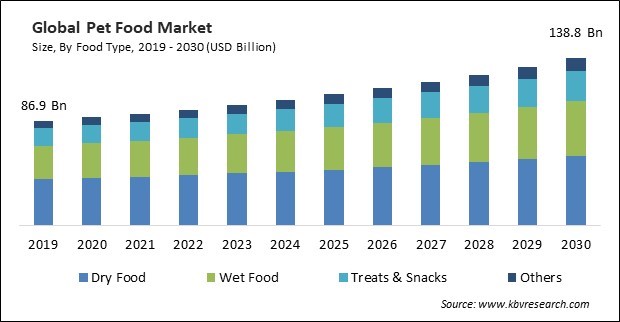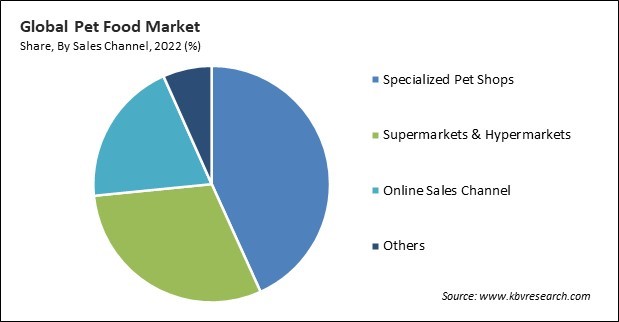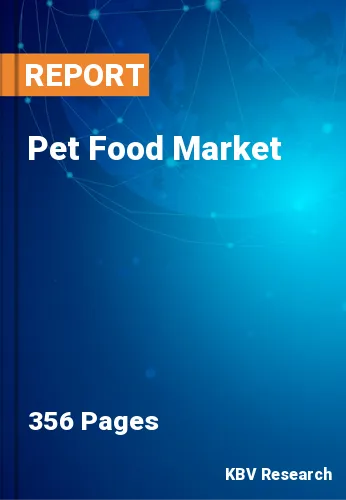The Global Pet Food Market size is expected to reach $138.8 billion by 2030, rising at a market growth of 4.8% CAGR during the forecast period. In the year 2022, the market attained a volume of 15,857.8 Kilo Tonnes experiencing a growth of 4.7% (2019-2022).
Pet ownership has increased in the Asia-Pacific region, with dogs and cats being the most popular pets. Pet owners in the Asia-Pacific region increasingly seek advice from veterinarians regarding pet nutrition and dietary choices. Consequently, the Asia-Pacific region would generate 43.1 billion revenues in the market by 2030. There is a growing trend of humanizing pets in the Asia-Pacific, like what has been observed in other parts of the world. Some of the factors affecting the market are increasing pet ownership and humanization, growing awareness of nutritional needs, and quality control and safety.

The fundamental driver of the market is the rising number of pet owners globally. As more people welcome pets into their homes, the demand for pet food naturally increases. The trend of pet humanization, in which pets are considered important family members, increases demand for high-quality pet food. As more people bring pets into their homes, the market benefits from an expanded customer base. Increased pet ownership and humanization drive substantial growth in the market. Moreover, with increased awareness of pet nutrition, pet owners are more likely to choose pet food that meets their pets' specific nutritional requirements. Veterinarian recommendations and disseminating nutritional knowledge play a significant role in shaping consumer choices. As a result of the growing awareness of nutritional needs, the market is anticipated to increase significantly.
However, maintaining consistent quality and safety in pet food production is a critical challenge. Contaminations, recalls, and quality control issues can harm a brand's reputation and trust. Contaminated or unsafe pet food can pose health risks to pets, which are beloved family members for many owners. Adverse health effects, including foodborne illnesses, can lead to emotional distress and medical expenses for pet owners. Ingredient supply chain disruptions are a significant challenge that hampers the growth of the market.
Based on food type, the market is classified into dry food, wet food, treats & snacks, and others. In 2022, the dry food segment witnessed the largest revenue share in the market. Dry pet food is extremely convenient for pet owners. It has a long shelf life and is simple to store, portion, and serve, making it a convenient alternative for individuals with busy lifestyles. Pet owners find dry pet food easy to handle and portion, simplifying feeding routines. This convenience encourages consistency in pet feeding, supporting pet health and well-being. Some dry pet food products are formulated to promote dental health by inhibiting the accumulation of tartar and plaque. The kibble's texture and crunch can help promote healthy teeth and gums.
On the basis of sales channel, the market is divided into specialized pet shops, supermarkets & hypermarkets, online sales channel, and others. The supermarkets & hypermarkets segment garnered a significant revenue share in the market in 2022. Supermarkets & hypermarkets have an extensive network of outlets, often with multiple locations in various neighbourhoods and cities. This broad reach ensures pet food products are readily accessible to many pet owners. Supermarkets and hypermarkets attract a high volume of shoppers, which includes a diverse customer base, including pet owners. These shoppers are likely to purchase pet food products while grocery shopping. Supermarkets & hypermarkets segment offer a wide range of pet food brands, formulations, and Flavors.

By pet type, the market is categorized into dog, cat, and others. In 2022, the dog segment held the highest revenue share in the market. The rise in household expenditure on nutritious dog food and the increased concern of dog owners regarding their pet's health contribute to this development. Dogs are carnivorous animals; hence, their diet consists primarily of meat. Dogs' relatively low carbohydrate requirements have increased the demand for products with a higher meat content and a lower starch content.
| Report Attribute | Details |
|---|---|
| Market size value in 2022 | USD 96.3 Billion |
| Market size forecast in 2030 | USD 138.8 Billion |
| Base Year | 2022 |
| Historical Period | 2019 to 2021 |
| Forecast Period | 2023 to 2030 |
| Revenue Growth Rate | CAGR of 4.8% from 2023 to 2030 |
| Number of Pages | 356 |
| Number of Table | 730 |
| Quantitative Data | Volume in Kilo Tonnes, Revenue in USD Billion, and CAGR from 2019 to 2030 |
| Report coverage | Market Trends, Revenue Estimation and Forecast, Segmentation Analysis, Regional and Country Breakdown, Porter’s 5 Forces Analysis, Company Profiling, Companies Strategic Developments, SWOT Analysis, Winning Imperatives |
| Segments covered | Pet Type, Food Type, Sales Channel, Region |
| Country scope |
|
| Companies Included | Unicharm Corporation (DSG International (Thailand) PLC), Farmina Pet Foods Holding B.V., Nestle S.A., General Mills, Inc., Mars, Inc. (Kind LLC), The Colgate Palmolive Company, The Wellness Pet Company (Clearlake Capital Group, L.P.), Schell & Kampeter, Inc., Archer Daniels Midland Company, and Thai Union Group PLC |
| Growth Drivers |
|
| Restraints |
|
Region-wise, the market is analysed across North America, Europe, Asia Pacific, and LAMEA. In 2022, the Asia Pacific region acquired a significant revenue share in the market. Pet ownership has increased in the Asia-Pacific region, with dogs and cats being the most popular pets. Pet owners in the Asia-Pacific region increasingly seek advice from veterinarians regarding pet nutrition and dietary choices. There is a growing trend of humanizing pets in the Asia-Pacific, like what has been observed in other parts of the world. Pet owners view their animals as family members and seek to provide them with the best possible care, including premium pet food in Asia Pacific.
Free Valuable Insights: Global Pet Food Market size to reach USD 138.8 Billion by 2030
The market research report covers the analysis of key stakeholders of the market. Key companies profiled in the report include Unicharm Corporation (DSG International (Thailand) PLC), Farmina Pet Foods Holding B.V., Nestle S.A., General Mills, Inc., Mars, Inc. (Kind LLC), The Colgate Palmolive Company, The Wellness Pet Company (Clearlake Capital Group, L.P.), Schell & Kampeter, Inc., Archer Daniels Midland Company, and Thai Union Group PLC
By Food Type (Volume, Kilo Tonnes, USD Million, 2019-2030)
By Sales Channel (Volume, Kilo Tonnes, USD Million, 2019-2030)
By Pet Type (Volume, Kilo Tonnes, USD Million, 2019-2030)
By Geography (Volume, Kilo Tonnes, USD Million, 2019-2030)
This Market size is expected to reach $138.8 billion by 2030.
Increasing pet ownership and humanization are driving the Market in coming years, however, Quality control and safety restraints the growth of the Market.
Unicharm Corporation (DSG International (Thailand) PLC), Farmina Pet Foods Holding B.V., Nestle S.A., General Mills, Inc., Mars, Inc. (Kind LLC), The Colgate Palmolive Company, The Wellness Pet Company (Clearlake Capital Group, L.P.), Schell & Kampeter, Inc., Archer Daniels Midland Company, and Thai Union Group PLC
In the year 2022, the market attained a volume of 15,857.8 Kilo Tonnes experiencing a growth of 4.7% (2019-2022).
The Specialized Pet Shops segment is leading the Market, by Sales Channel in 2022,there by, achieving a market value of $57.2 Billion by 2030.
The North America region dominated the Market, by region in 2022, and would continue to be a dominant market till 2030;there by, achieving a market value of $47.2 Billion by 2030.
Our team of dedicated experts can provide you with attractive expansion opportunities for your business.

